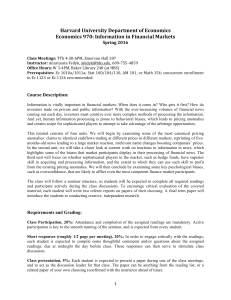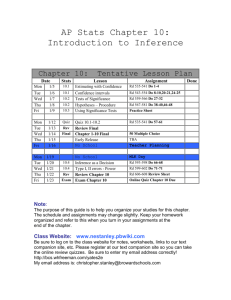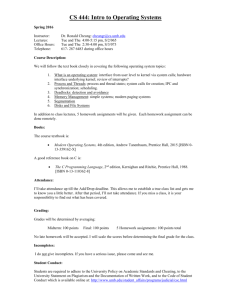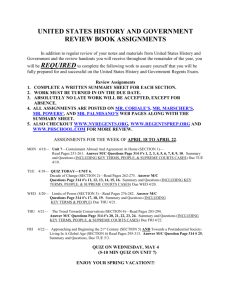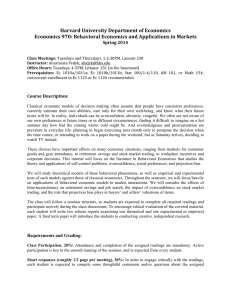Document 10769184
advertisement
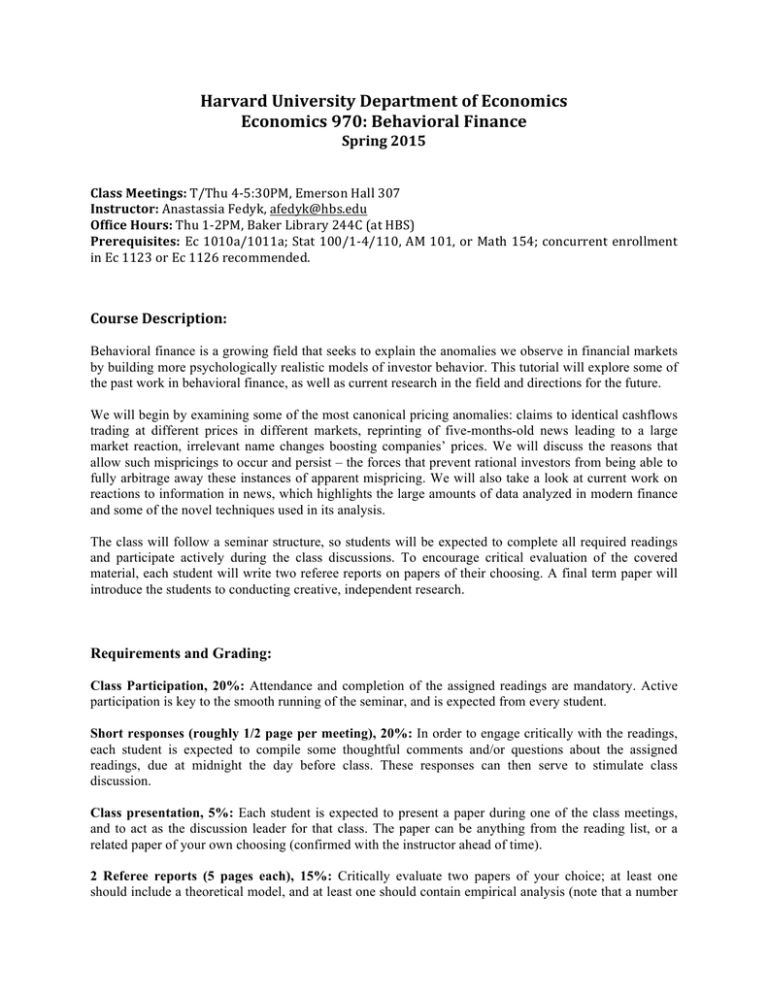
Harvard University Department of Economics Economics 970: Behavioral Finance Spring 2015 Class Meetings: T/Thu 4-­‐5:30PM, Emerson Hall 307 Instructor: Anastassia Fedyk, afedyk@hbs.edu Office Hours: Thu 1-­‐2PM, Baker Library 244C (at HBS) Prerequisites: Ec 1010a/1011a; Stat 100/1-­‐4/110, AM 101, or Math 154; concurrent enrollment in Ec 1123 or Ec 1126 recommended. Course Description: Behavioral finance is a growing field that seeks to explain the anomalies we observe in financial markets by building more psychologically realistic models of investor behavior. This tutorial will explore some of the past work in behavioral finance, as well as current research in the field and directions for the future. We will begin by examining some of the most canonical pricing anomalies: claims to identical cashflows trading at different prices in different markets, reprinting of five-months-old news leading to a large market reaction, irrelevant name changes boosting companies’ prices. We will discuss the reasons that allow such mispricings to occur and persist – the forces that prevent rational investors from being able to fully arbitrage away these instances of apparent mispricing. We will also take a look at current work on reactions to information in news, which highlights the large amounts of data analyzed in modern finance and some of the novel techniques used in its analysis. The class will follow a seminar structure, so students will be expected to complete all required readings and participate actively during the class discussions. To encourage critical evaluation of the covered material, each student will write two referee reports on papers of their choosing. A final term paper will introduce the students to conducting creative, independent research. Requirements and Grading: Class Participation, 20%: Attendance and completion of the assigned readings are mandatory. Active participation is key to the smooth running of the seminar, and is expected from every student. Short responses (roughly 1/2 page per meeting), 20%: In order to engage critically with the readings, each student is expected to compile some thoughtful comments and/or questions about the assigned readings, due at midnight the day before class. These responses can then serve to stimulate class discussion. Class presentation, 5%: Each student is expected to present a paper during one of the class meetings, and to act as the discussion leader for that class. The paper can be anything from the reading list, or a related paper of your own choosing (confirmed with the instructor ahead of time). 2 Referee reports (5 pages each), 15%: Critically evaluate two papers of your choice; at least one should include a theoretical model, and at least one should contain empirical analysis (note that a number of papers feature both, theory and empirics). One of these two papers should coincide with the class presentation above. Referee reports are due at the start of class in which the paper in question will be covered. At least one referee report should be written before the Spring Break. STATA Tutorial Problem Sets, 10%: You will be assigned four problem sets in the required STATA tutorial, which will be counted towards your Ec970 grade. Term paper (12-15 pages, not including figures and appendices), 25% (of which 5% is based on the 5-page proposal): Each student is expected to conduct independent research on a relevant theoretical or empirical topic of interest. The purpose of the term paper is to learn the skills of formulating an interesting research question, developing a methodology to approach the problem, and presenting the results in a clean and effective manner. Term paper presentation, 5%: Each student is expected to deliver a short (~15 minute) talk about his or her term paper during the last week of class, followed by 5-10 minutes of questions. Active participation during these presentations is key, and the class should function analogously to an academic seminar discussing novel research. Key Dates and Deadlines: Thursday, Feb. 12: Student selections of papers for referee reports and presentations are due by midnight via email or personal communication. Friday, March 13: Last day to submit term paper proposals, due by midnight. March 17 and 19: No classes due to Spring Break. Thursday, April 16: Draft of the term paper due by midnight. Tuesday, April 21: Last day to lead discussions or turn in referee reports. Monday, May 4: Term paper due by 5PM, via email. Lateness Policy: Any assignments turned in after the deadlines outlined above will be penalized at the rate of 10% per day of lateness. STATA Tutorial As part of the Ec970 course, you will also be required to attend the STATA tutorial, and turn in four problem sets (which will be counted towards your 970 grade). The tutorial will be held on February 10, February 24, March 10, and March 31. The time will be 8:30-10AM. The STATA tutorial will be taught by Jane Herr (email: jlherr@fas.harvard.edu). Here is a link to the iSite: http://isites.harvard.edu/icb/icb.do?keyword=k12758&pageid=icb.page649769. There will be four problem sets, with the following due dates (you can either turn these in to me in class, or email by midnight of the indicated date): February 20, March 6, March 27, 2015, and April 10, 2015. Academic Honesty Discussing ideas and work-in-progress with others is an important and desirable part of the research process, but in the end, a student’s assignment must be his or her own effort, written by the student, and ultimately based on his or her own thinking. All written assignments must use appropriate citation practices. For questions about Harvard’s stance on academic onesty, please consult the Academic Information section in the Harvard College Handbook for Students. Schedule and Reading List Tue, Feb 3: Logistics and Seminar Overview Thu, Feb. 5: Introduction to Behavioral Finance Tue, Feb. 12: Anomalies: Effects of Non-News • Huberman, G., and T. Regev (2001). "Contagious speculation and a cure for cancer: A nonevent that made stock prices soar." The Journal of Finance, 56(1): 387-396. • Wade, Nicholas (1997) “Tests on mice block defense by cancer.” New York Times, November 27, A28. • Kolata, Gina (1998) “Hope in the lab: A special report; A cautious awe greets drugs that eradicate tumors in mice.” New York Times, May 3, 1:1. Thu, Feb. 12: Anomalies: Name Changes • Cooper, M. J., O. Dimitrov, and P. R.a Rau (2001). "A Rose.com by any other name." The Journal of Finance, 56(6): 2371-2388. • Cooper, M. J., et al (2005). "Managerial actions in response to a market downturn: Valuation effects of name changes in the dot. com decline." Journal of Corporate Finance, 11(1): 319-335. Tue, Feb. 17: Anomalies: Can the market multiple by 1.5? • Rosenthal, L., and C. Young (1990). "The seemingly anomalous price behavior of Royal Dutch/Shell and Unilever NV/PLC." Journal of Financial Economics, 26(1): 123-141. • Lamont, O. A., and R. H. Thaler (2003). "Anomalies: The law of one price in financial markets." The Journal of Economic Perspectives, 17(4): 191-202. Thu, Feb. 19: Anomalies: over- and under- reaction • De Bondt, W. F. M., and R. Thaler (1985). "Does the stock market overreact?." The Journal of Finance, 40(3): 793-805. • Jegadeesh, N., and S. Titman (1993). "Returns to buying winners and selling losers: Implications for stock market efficiency." The Journal of Finance, 48(1): 65-91. Tue, Feb. 24: Explaining under- and over- reactions • Barberis, N., A. Shleifer, and R. Vishny (1998). "A Model of Investor Sentiment." Journal of financial economics 49(3): 307-343. • Hong, H., and J. C. Stein (1999). "A unified theory of underreaction, momentum trading, and overreaction in asset markets." The Journal of Finance 54(6): 2143-2184. Thu, Feb. 26: Limits of Arbitrage • Shleifer, A., and R. W. Vishny (1997). "The Limits of Arbitrage." The Journal of Finance, 52.1: 35-55. Tue, March 3: Location of Trade • Froot, K. A., and E. M. Dabora (1999). "How are stock prices affected by the location of trade?" Journal of Financial Economics, 53(2): 189-216. • Engelberg, J. E., and C. A. Parsons (2011). "The causal impact of media in financial markets." The Journal of Finance, 66(1): 67-97. Thu, March 5: Prospect Theory • Kahneman, D., and A. Tversky (1979). ”Prospect theory: An analysis of decision under risk.” Econometrica, 47(2): 263-291. • Tversky, A., and D. Kahneman (1992). "Advances in prospect theory: Cumulative representation of uncertainty." Journal of Risk and Uncertainty, 5(4): 297-323. Tue, March 10: Prospect Theory • Camerer, C. F. (2004). ”Prospect theory in the wild: Evidence from the field.” C. F. Camerer, G. Loewenstein, and M. Rabin, eds., Advances in Behavioral Economics • Barberis, N. (2012). "A model of casino gambling." Management Science, 58(1): 35-51. Thu, March 12: Disposition Effect • Odean, T. (1998). ”Are Investors Reluctant to Realize Their Losses?” Journal of Finance, 53(5): 1775-1798. • Frazzini, A. (2006). "The disposition effect and underreaction to news." The Journal of Finance, 61(4): 2017-2046. . Spring Break Dates: Spring Break, no classes Tue, March 24: Investor (In)attention • DellaVigna, S., and J. M. Pollet (2009). "Investor inattention and Friday earnings announcements." The Journal of Finance 64(2): 709-749. • Barber, B. M., and T. Odean (2008). "All that glitters: The effect of attention and news on the buying behavior of individual and institutional investors." Review of Financial Studies, 21(2): 785-818 Thu, March 26: Effects of Non-News, revisited • Tetlock, P. C. (2011). "All the news that's fit to reprint: Do investors react to stale information?." Review of Financial Studies, 24(5): 1481-1512. • Fedyk, A. and J. Hodson (2014). “Aggregation Effect in Stale News.” Working paper. Tue, March 31: Underreaction to bad news • Chan, W. (2003). “Stock price reaction to news and no-news: drift and reversal after headlines.” Journal of Financial Economics, 70: 223-260. Thu, April 2: News sentiment • Tetlock, P. C. (2007). "Giving content to investor sentiment: The role of media in the stock market." The Journal of Finance, 62(3): 1139-1168. • Das, S. R., and M. Y. Chen (2007). "Yahoo! for Amazon: Sentiment extraction from small talk on the web." Management Science, 53(9): 1375-1388. Tue, April 7: Catering to news demand • Mullainathan, S., and A. Shleifer (2005). "The market for news." American Economic Review, 95(4): 1031-1053. • Gentzkow, M. and J. Shapiro (2006). “Media Bias and Reputation.” Journal of Political Economy, 114(2): 280-316. Thu, April 9: Who writes the news? • Ahern, K.R. and D. Soyura (2014). “Who Writes the News? Corporate Press Releases during Merger Negotiations.” The Journal of Finance, 69(1): 241-291. Tue, April 14: Overconfidence: trading behavior • Odean, T. (1999). “Do Investors Trade Too Much?” The American Economic Review, 89(5): 1279-1298 • Barber, B. M., and T. Odean (2001). "Boys will be boys: Gender, overconfidence, and common stock investment." The Quarterly Journal of Economics, 116(1): 261-292. Thu, April 16: Overconfidence: executive behavior • Malmendier, U., and G. Tate (2005). "CEO overconfidence and corporate investment." The Journal of Finance, 60(6): 2661-2700. Tue, April 21: Overconfidence: executive incentives • Gervais, S., J. B. Heaton, and T. Odean (2011). "Overconfidence, compensation contracts, and capital budgeting." The Journal of Finance, 66(5): 1735-1777. Thu, April 23: Student Presentations Tue, April 28: Student Presentations


